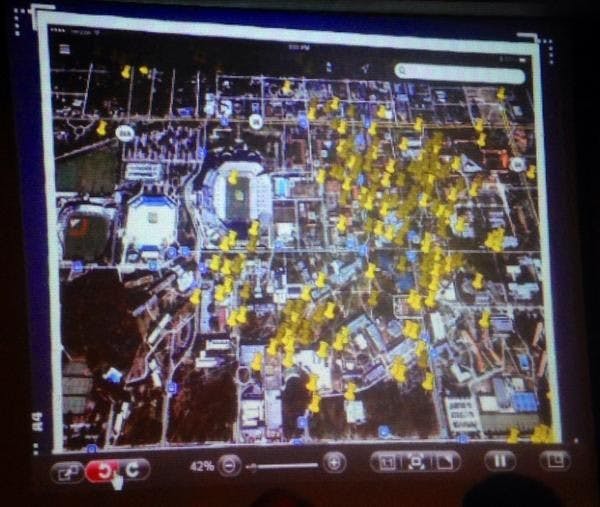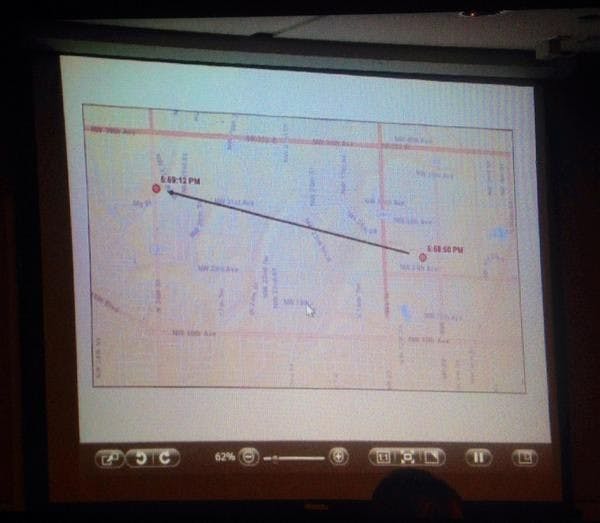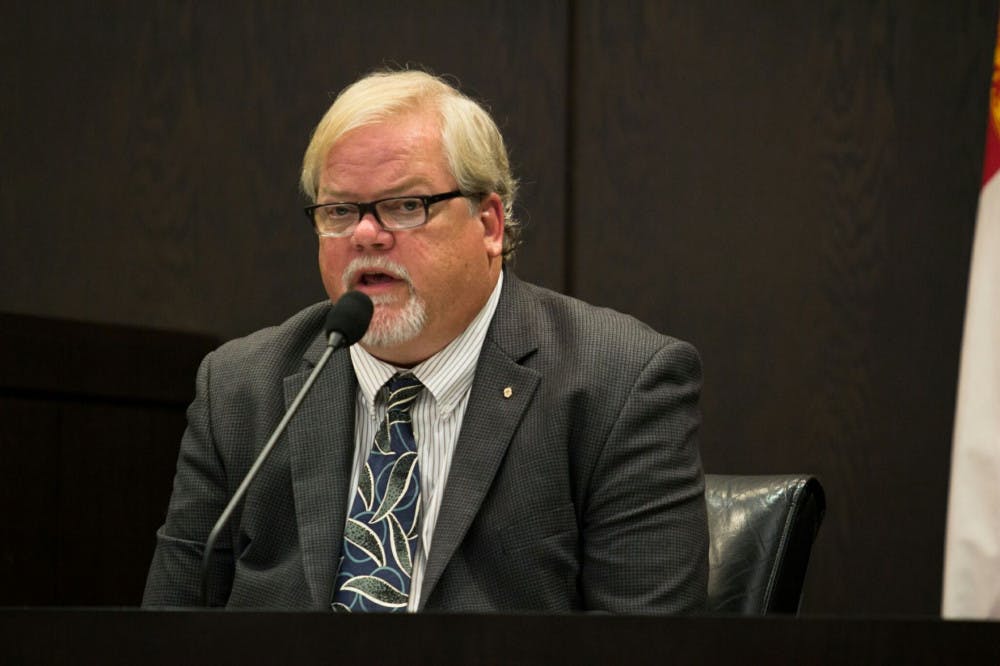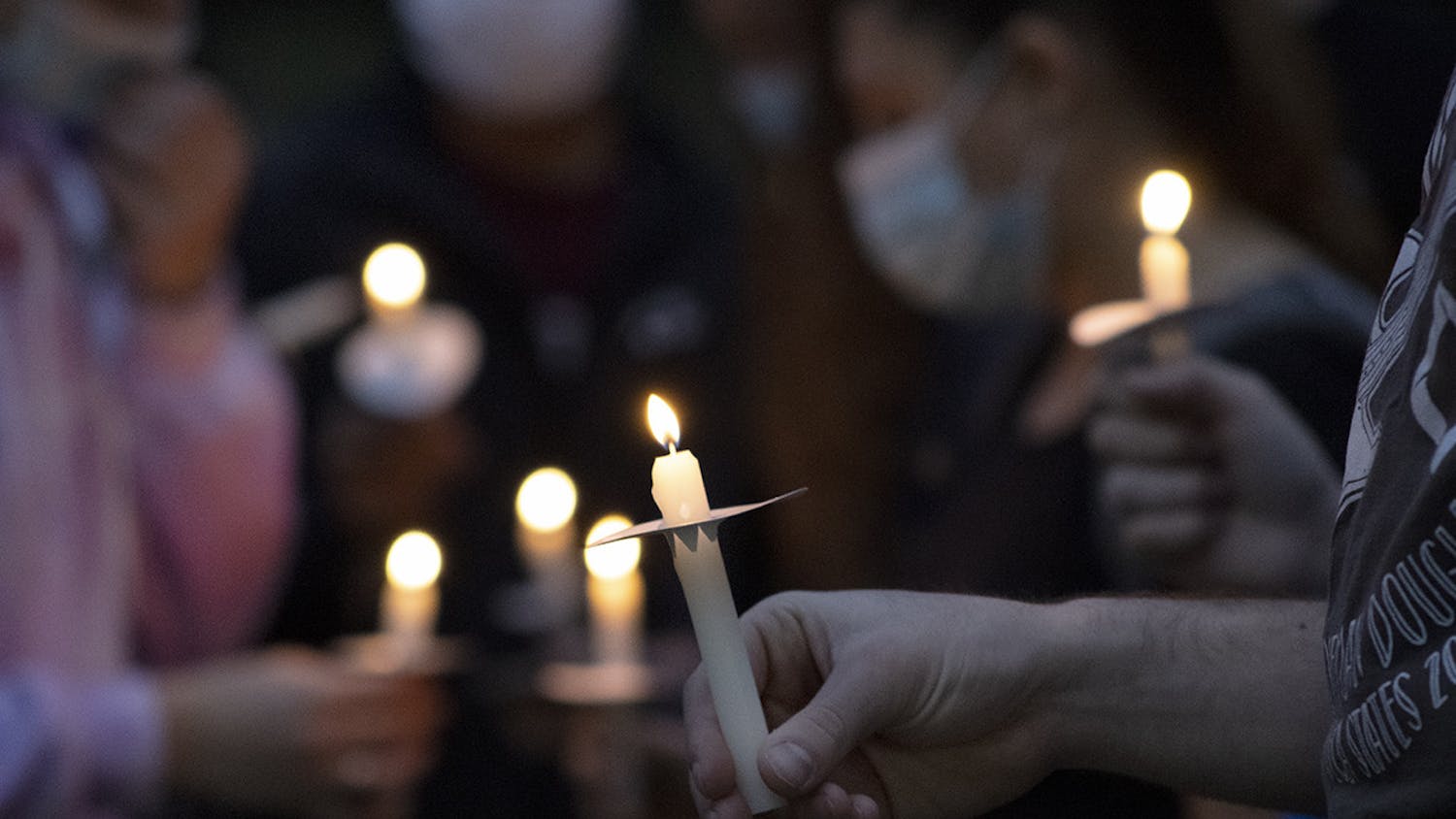If you ask the state, Pedro Bravo had a busy night on Sept. 20, 2012.
Gainesville Police Detective Matthew Goeckel searched the phone records of Erika Friman, Pedro Bravo, Christian Aguilar and his parents, Claudia and Carlos Aguilar. He said he used the data as an approximation of location and travel direction.
Bravo uses Verizon Wireless, which “checks in” with a nearby tower every five minutes, whether or not the user is doing anything with the phone.
This data totaled hundreds of location points, which were charted on a Google Map. Verizon doesn’t release its algorithm, but it ranks each of the locations with a confidence value — high, medium or low.

A map of all the location data points from Bravo's phone. UF's Ben Hill Griffin Stadium is visible.
However, they were not all entirely accurate, as the defense pointed out. Two points, one minute apart, appear to show Bravo traveling 2.5 miles in 60 seconds.

The defense shows two "high confidence" points, a minute apart and 2.5 miles away from each other.
Goeckel also used data from Aguilar’s phone, which uses Metro PCS, but not that much data could be collected because it doesn’t “reach out” automatically like Verizon phones.
At 4:09 p.m., both Bravo and Aguilar were near Wal-Mart, where they remained for about two and a half hours.
Aguilar texted his mother at 6:26 p.m., a picture of the receipt for his flu shot.
“Bien :) me dieron una vacunación gratis,” he wrote.
Just an hour later, at 7:20 p.m. Aguilar received a call from his girlfriend, Friman. He didn’t answer.
Five minutes later, Bravo’s phone was located near Alley Katz Bowling, on Southwest 34th Street. Aguilar’s phone call shows his phone was in the same location as Bravo’s at that time.
Records show Bravo’s phone was at Spyglass Apartments at 7:32 p.m., where it remained for about 15 minutes.
At 7:53 p.m. Bravo spoke with his dad on the west side of Butler Plaza about his recent car accident.
At 8 p.m., Bravo’s phone was at 48 percent battery when it was disconnected from the network. Aguilar’s phone also disconnected from the network at the same, but it has never been reconnected.
Goeckel said there are a few ways to disconnect a phone from the network, but switching a phone to “airplane mode” is the simplest and most common.
Bravo’s didn’t reconnect to the network until 1:23 a.m. the next morning.
A receipt found in Bravo’s car shows he went to McDonald’s at 12:55 a.m., and Scrubbs Car wash, about a minute drive away, afterward.
Security footage officers retrieved from Scrubbs showed that a car matching the description of Bravo’s SUV entered one of the self-service bays, paid and drove away, leaving wet tires tracks.
Bravo’s phone was disconnected from the network again at 1:54 a.m., when it only had 17 percent battery. At 3:40 a.m., it reconnected at Spyglass Apartments.
In that 24-hour period, Bravo’s flashlight app was used nine times, for a total of 48 minutes. The major battery drain of a phone on Airplane mode, which uses less battery power than normal operations, led the state to believe Bravo used the flashlight to light up the grave site.
***
That was the last time anyone visited the shallow grave in Levy County for 22 days, until two young hunters found the remains and called the police.
Along with officers came a team of medical examiners and forensic anthropologists.
Dr. Martha Burt is a medical examiner for the 8th District, which encompasses both Levy and Alachua counties.
Burt found the body in a small clearing in the woods, about 23 feet from the road.
“The remains were partially skeletonized with clothing intimately associated with the remains,” she said.
She saw a pair of mud-caked, partially buried blue jeans, Vans and a Volcom T-shirt intertwined with scattered bones and small bits of soft tissue.
The wrists and ankles were covered in loops of duct tape, and there were matted remnants of duct tape around the neck as well.
Not every bone was present, she said, which was probably the work of scavenging animals.
One of the most important bones missing was a vertebra in the neck, which is crucial for determining if the cause of death was strangulation.
Burt and her team tested the “deepest and most protected” soft tissue for poisons. None were found in Aguilar’s system, but Burt said she wouldn’t be surprised if he was poisoned. She said the most accurate materials to test for poisoning are blood, urine and eyeball fluid, which were not present.
The death was ruled “homicide by unspecified means” because Burt was able to rule out suicide, natural death and accidents.
However, she was unable to find evidence of penetrating injuries — gunshot wounds, stab wounds, etc.
The lack of facial fractures led her to believe death by beating was “relatively unlikely.” The defense pointed out that certain injuries, including concussions, bruises or subdural hematomas, cannot be detected at the skeletal level.
Burt also looked at photos of Bravo taken in Sept. 2012 for evidence of injuries from a fight “that were so great as to result in the death of another.” She found none.
Also on the scene were forensic entomologists, who collected the flies, larvae and pupae found on the remains. The age of the insects and temperature of the surroundings are used to determine an approximate time of death.
Dr. Jason Byrd, assistant director for the Maples Center for Forensic Medicine and a forensic entomologist, estimated that colonization by insects probably began around Sept. 30, and death occurred prior to that.
The state pointed out that a burial would slightly delay insect colonization.
The forensic anthropologist on the scene was Dr. Michael Warren, the director of C.A. Pound Human Identification Laboratory and a UF professor.

Dr. Michael Warren, from the C.A. Pound Human Identification Lab, looks at Bravo as he testified Wednesday.
Before the dental identification was made, Warren was able to determine that the body recovered was a Hispanic male between the ages of 17 and 21.
From the marks in the dirt, Warren came to the conclusion that a shovel was used for this burial, which he estimates took from 30 minutes to an hour.
He placed the time of death at less than three weeks before it was recovered, but more than a week.
From the distance to the grave site to the road —23 feet — Warren concluded that Aguilar was most likely dead before being buried. The body was probably too heavy to drag farther, he said.
Details from the crime scene were used by other experts to add evidence to the state’s account.
Marianne Hildreth, a senior crime analyst for the Florida Department of Law Enforcement, did fracture matches between the duct tape found on Aguilar’s body and the tape on Bravo’s broken windshield.
She found an exact match between one of the pieces used on Bravo’s window and one found wrapped around Aguilar’s ankles.
Today, the state is expected to call its last witness. Bravo still has the choice to testify as well.





